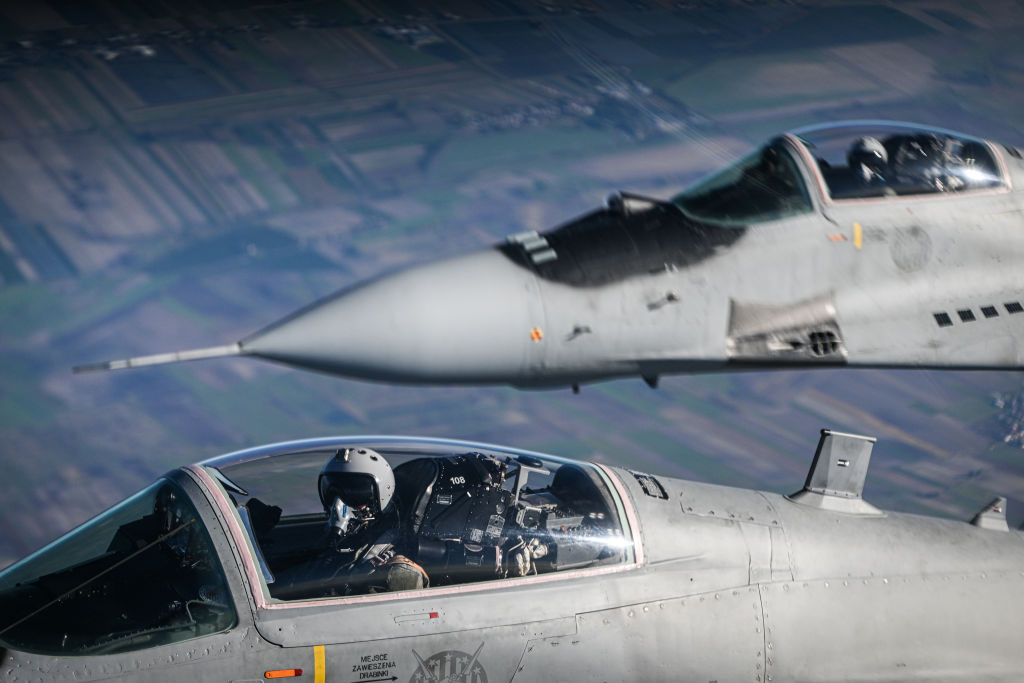Slovakia approved a plan to send a fleet of 13 MiG-29 fighter jets to Ukraine, a day after Poland became the first NATO country to say it would send warplanes to Ukraine.
“Promises must be kept & when @ZelenskyyUa asked for more #weapons incl. fighter jets, I said we’ll do our best,” Prime Minister Eduard Heger tweeted, adding that he was glad other nations were doing the same.
Poland’s President Andrzej Duda announced Thursday that the country plans to give Ukraine about a dozen MiG-29 fighter jets. That announcement marked the first time an ally of Ukraine said it would provide warplanes in the fight against Russia. Poland and Slovakia’s back-to-back decisions will likely apply pressure on other Western nations to provide military aircraft amid pleas from Ukraine ahead of a likely counter-offensive this Spring.
So far, the U.S., U.K., and Germany have rejected Ukraine’s requests for fighter aircraft.
“This might be a turning point for when Western capitals start to reevaluate their previous decisions to refuse to send Ukraine fixed wing aircraft,” says George Barros, an analyst specializing in Russia and Ukraine at the Institute for the Study of War.
Duda said during a news conference in Warsaw that four of the MiG-29s would arrive “within the next few days” and the rest would come at a later date after being serviced. Poland has a total of 28 MiG-29 jets. The multi-role fighter jets, nicknamed Fulcrum by NATO, were designed by the Soviet Union and first exported to Poland in the 1980s.
Poland plans to replace the MiGs with South Korean FA-50s Golden Eagle light fighter jets and American F-35 Lightning II stealth fighters. Since the start of the Russian invasion last year, Poland has been a key ally for Ukraine. It was the first country to send German-made Leopard 2 tanks and has taken in the highest number of Ukrainian refugees.
More from TIME
Why the MiG-29?
Poland and Slovakia’s announcements comes one year after the former first proposed sending the MiG jets to Ukraine as part of a deal that would have included the U.S. sending F-16 fighters to Poland as replacement. The proposal ultimately fell through amid U.S. concerns about escalation.
“When it comes to the MiG-29 aircraft, which are still operating in the defense of Polish airspace, a decision has been taken at the highest levels, we can say confidently that we are sending MiGs to Ukraine,” Duda said.
Poland currently has 94 combat aircraft, with U.S. F-16 Fighting Falcons making up most of its fighter squadrons.
Ukrainian pilots are familiar with the MiG-29; the Ukrainian air force had 36 of them at the start of the war. It’s likely that the new fighters would be used primarily in an air defense capacity to keep the skies clear of Russian aircraft and shoot down Russian cruise missiles, says Ian Williams, deputy director of CSIS’s Missile Defense Project. “It’s very fast and very maneuverable,” Williams says. They could be key to protecting Ukrainian infrastructure and the frontlines. “Having more aircraft allows (Ukraine) to fill in gaps to engage missiles earlier,” Williams adds.
Despite Ukrainian President Volodymyr Zelensky asking Western allies vociferously for fighter jets, so far, none except Poland and Slovakia have agreed. That’s at least partially because they don’t want to provoke Russia, which they fear could view such assistance as a significant escalation of their participation in the war, Barros says. Fighter jets, unlike tanks or armored vehicles, could more easily be used to carry out strikes inside Russia.
Polish government spokesman Piotr Mueller said ahead of Slovakia’s announcement Friday that some other countries have promised MiGs; he did not name them.
“So far, everyone has agreed that it’s not the time to send fighter jets,” German Defense Minister Boris Pistorius told reporters.
White House officials said Thursday that Poland’s “sovereign decision” would not affect “our calculus” when deciding whether to send American F-16 fighters to Ukraine. Biden said earlier this year that the U.S. would not provide Ukraine with fighter jets.
But it’s unclear how firm these positions are.

If the U.S. does end up sending fighter jets, it wouldn’t be the first time the Biden Administration reversed course on sending sophisticated military equipment that they previously hesitated to share. After the U.K. sent 14 Challenger 2 tanks to Ukraine in early January, the U.S. followed up that same month, announcing it would send over 31 M1 Abrams tanks.
“We—the collective West, and the decision makers in our capitals—have slowly come to the realization that the demands of the Ukrainian battlefield are so intense, and these weapons systems actually filled those capability gaps, that if we want the Ukrainians to win—like we say we do—we actually need to give them more stuff,” Barros says. “It’s just another iteration of that same song and dance.”
Oleksii Reznikov, the Ukrainian defense minister, said this week that a successful Ukrainian counteroffensive will require fighter jets. “The sooner we get combat aircraft, the more human lives will be saved,” Reznikov said.
More aircraft will allow Ukraine to make better use of its arms in general. That’s because military equipment, like tanks and planes, are more effective when used as part of a larger strategy, Barros says. What’s more, Ukrainians are familiar with operating MiG 29s. They don’t need new training, Barros says.
— ARMANI SYED CONTRIBUTED REPORTING FROM LONDON
More Must-Reads from TIME
- Donald Trump Is TIME's 2024 Person of the Year
- Why We Chose Trump as Person of the Year
- Is Intermittent Fasting Good or Bad for You?
- The 100 Must-Read Books of 2024
- The 20 Best Christmas TV Episodes
- Column: If Optimism Feels Ridiculous Now, Try Hope
- The Future of Climate Action Is Trade Policy
- Merle Bombardieri Is Helping People Make the Baby Decision
Write to Sanya Mansoor at sanya.mansoor@time.com